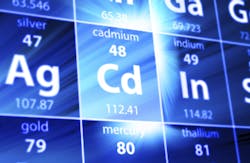Taking a closer look at the effects of cadmium
BIRMINGHAM — In Water Technology’s Contaminant of the Month featured in the February issue, Technical Editor Dr. Joseph Cotruvo writes about cadmium. Cotruvo takes a closer look at what it is, the uses of cadmium, human exposure and occurrence, potential health considerations, analytical methods, available water treatment and how it is regulated.
Cadmium, Cotruvo explains in the article, is a silvery white metal in the same chemical family as zinc with similar chemical properties but is substantially more toxic. It can be frequently found as salts in ores.
Cotruvo continues that the daily intake of cadmium from food is around 8 to 30 micrograms a day in the U.S., and recent U.S. production of cadmium is around 600 metric tons per year, which is declining; occupational exposure is significant mostly by inhalation in many manufacturing activities like metal refining and welding.
“Water is a minor source of exposure,” Cotruvo adds. “Only two of 983 groundwaters exceeded the 0.005 mg/l MCL in the 1988 National Inorganics and Radionuclides Survey, and 979 of 983 supplies had less than 0.002 mg/l.”
In the article, Cotruvo lists the health considerations associated with cadmium:
- Cadmium compounds are considered to be carcinogenic by inhalation but not by ingestion.
- It is estimated that only two to six percent of ingested cadmium is taken up by the body compared to 30 to 64 percent of inhaled cadmium.
- The kidney is the general target organ where it accumulates, as well as the lung from inhaled cadmium.
- Cumulative exposure to cadmium is tracked by its concentration in urine.
- Irreversible kidney damage occurs from excess acute and chronic exposure, leading to kidney failure and also indirect consequences of kidney damage such as hypertension, muscle weakness and gout.
- Itai-itai disease in Japan was associated with cadmium in the 1960s and is one of the frequently cited examples of disease from environmental contamination. However, it probably occurred for over 100 years because of uncontrolled mining and manufacturing waste releases in the area.
Cadmium can be removed by conventional drinking water treatment and lime softening, reports Cotruvo adding that cation exchange water softening point-of-entry (POE) and point-of-use reverse osmosis (RO) can also be effective.
Cotruvo notes that the MCL is 0.005 mg/l, and very few drinking water supplies have been reported to exceed this regulation.
You can find January’s Contaminant of the Month on cadmium here.
